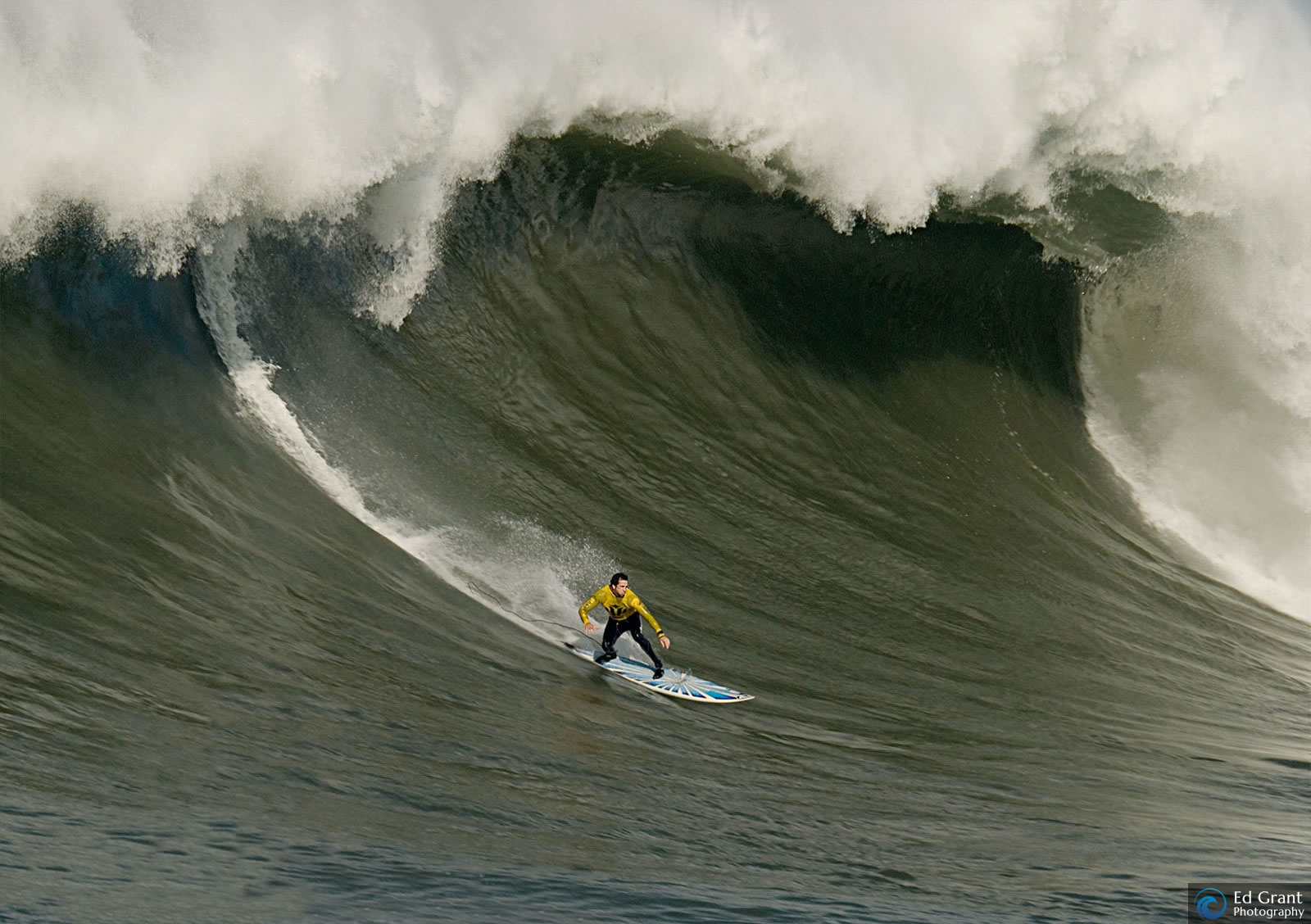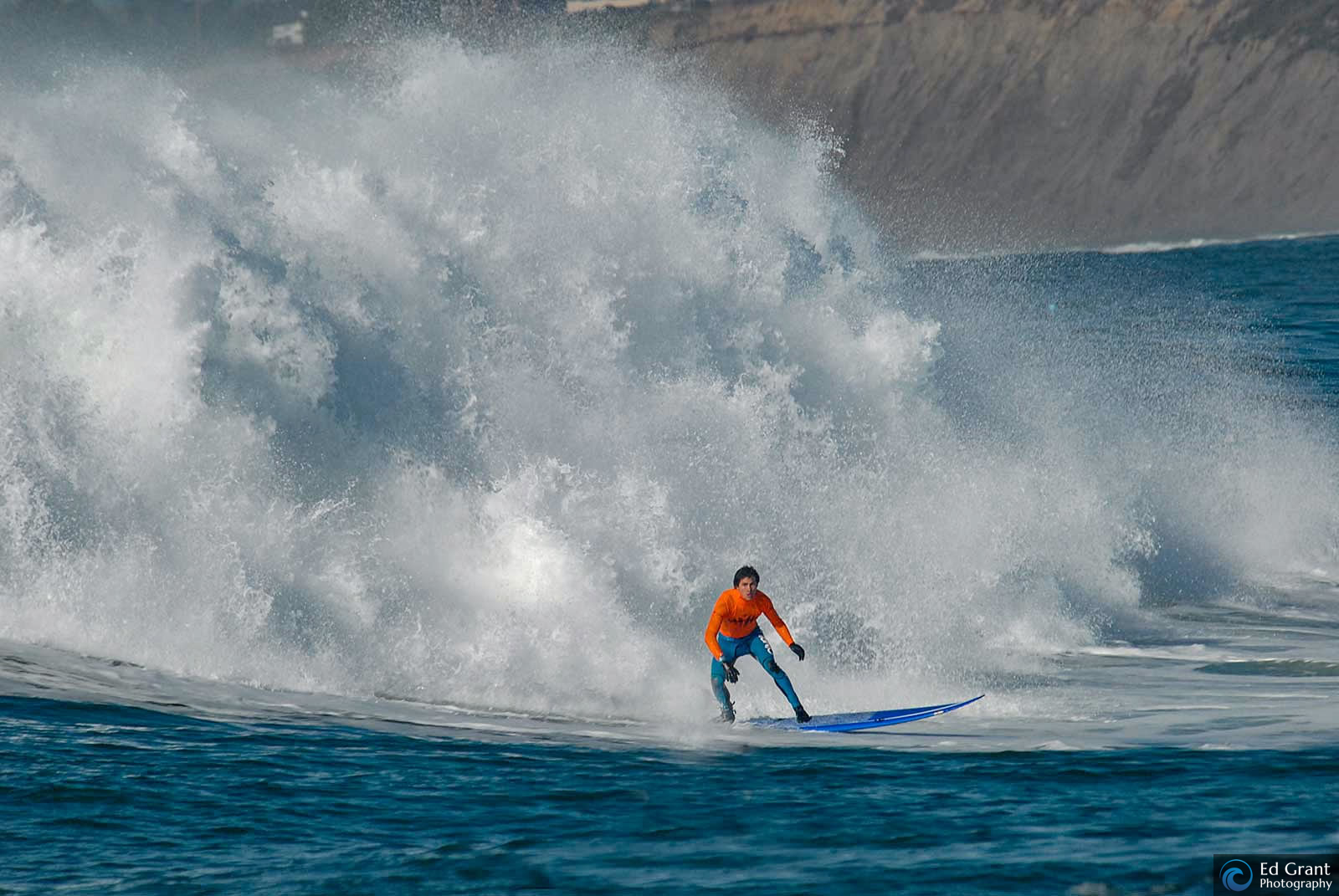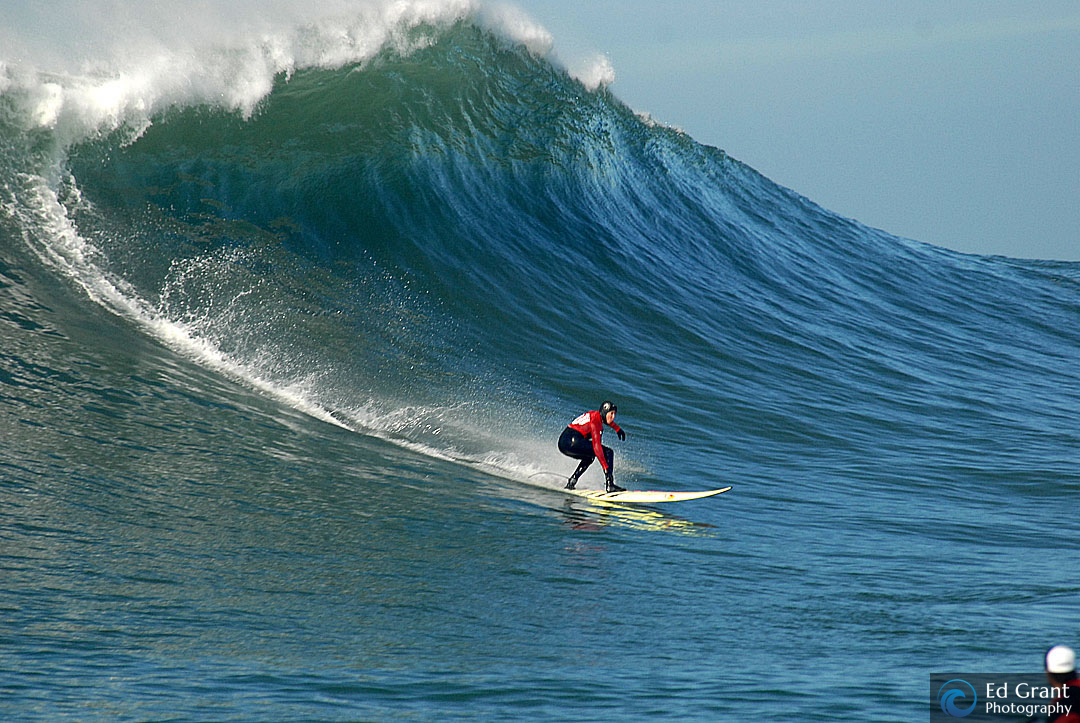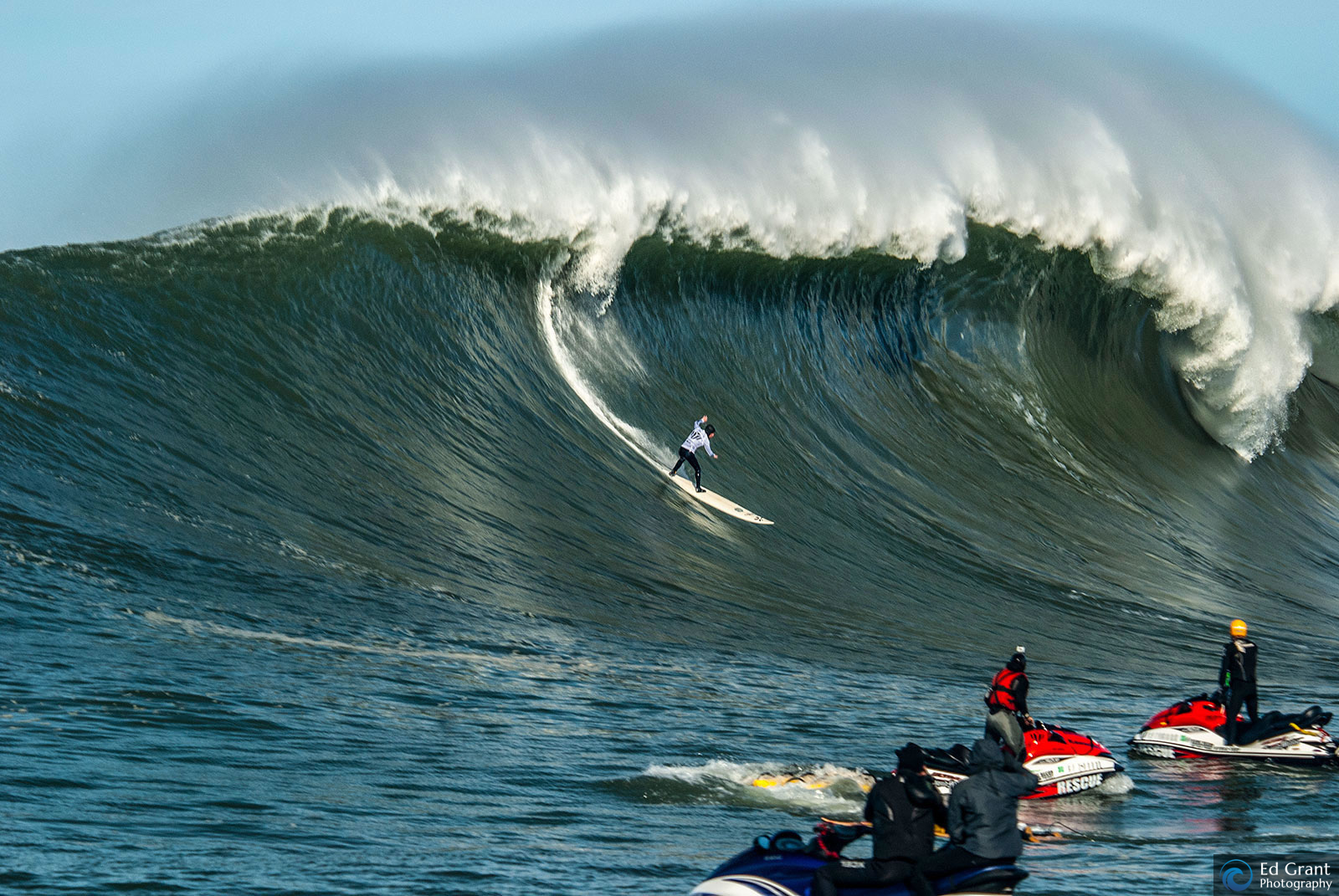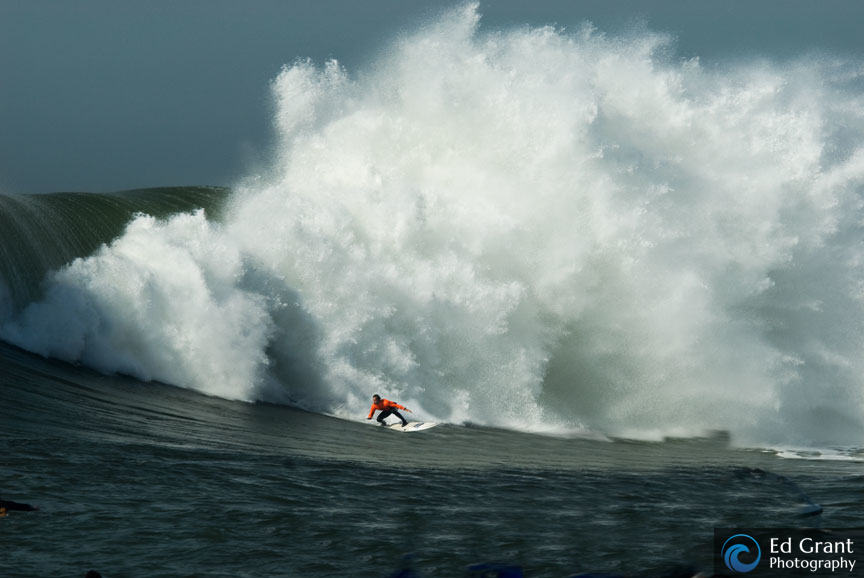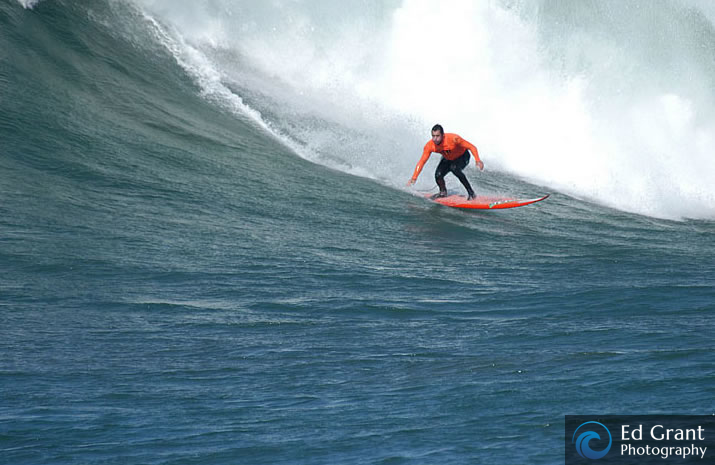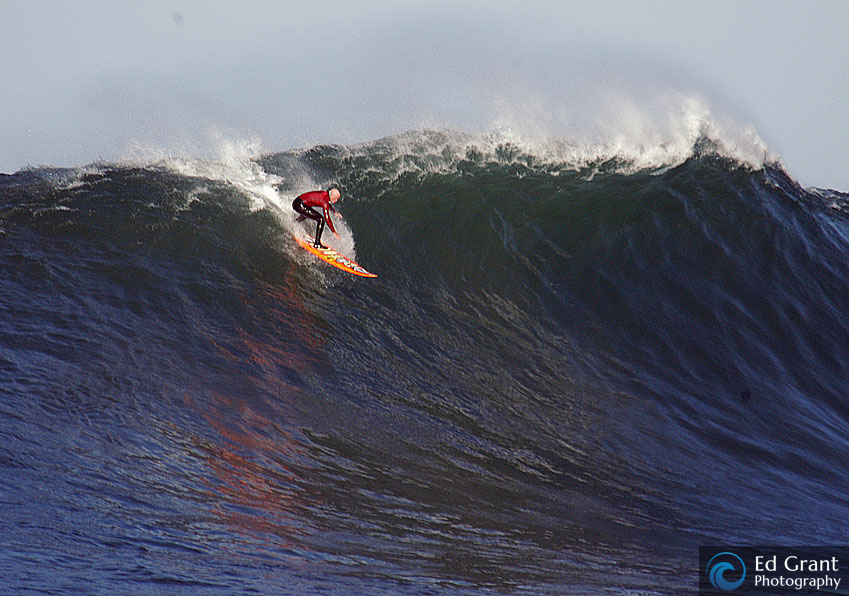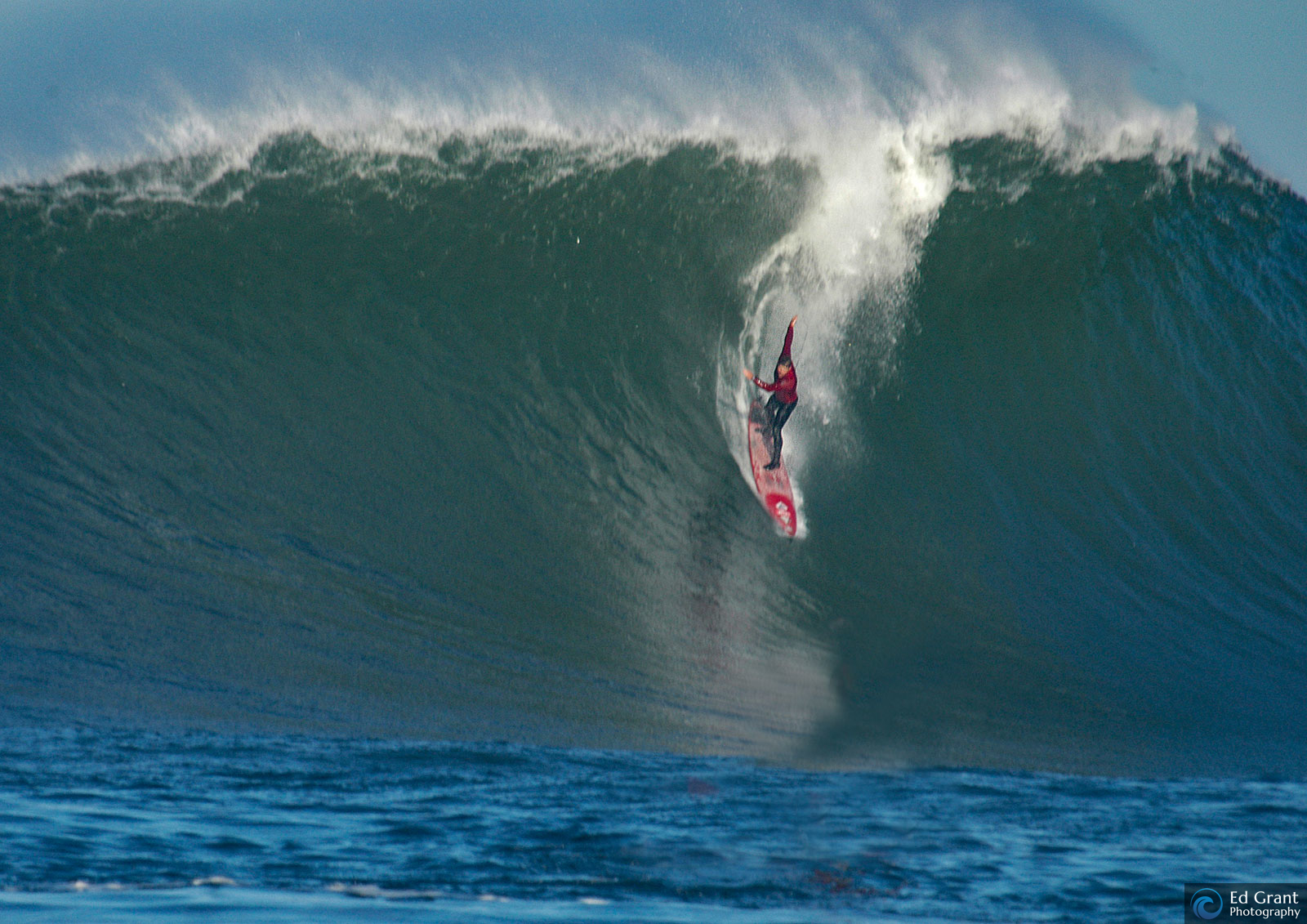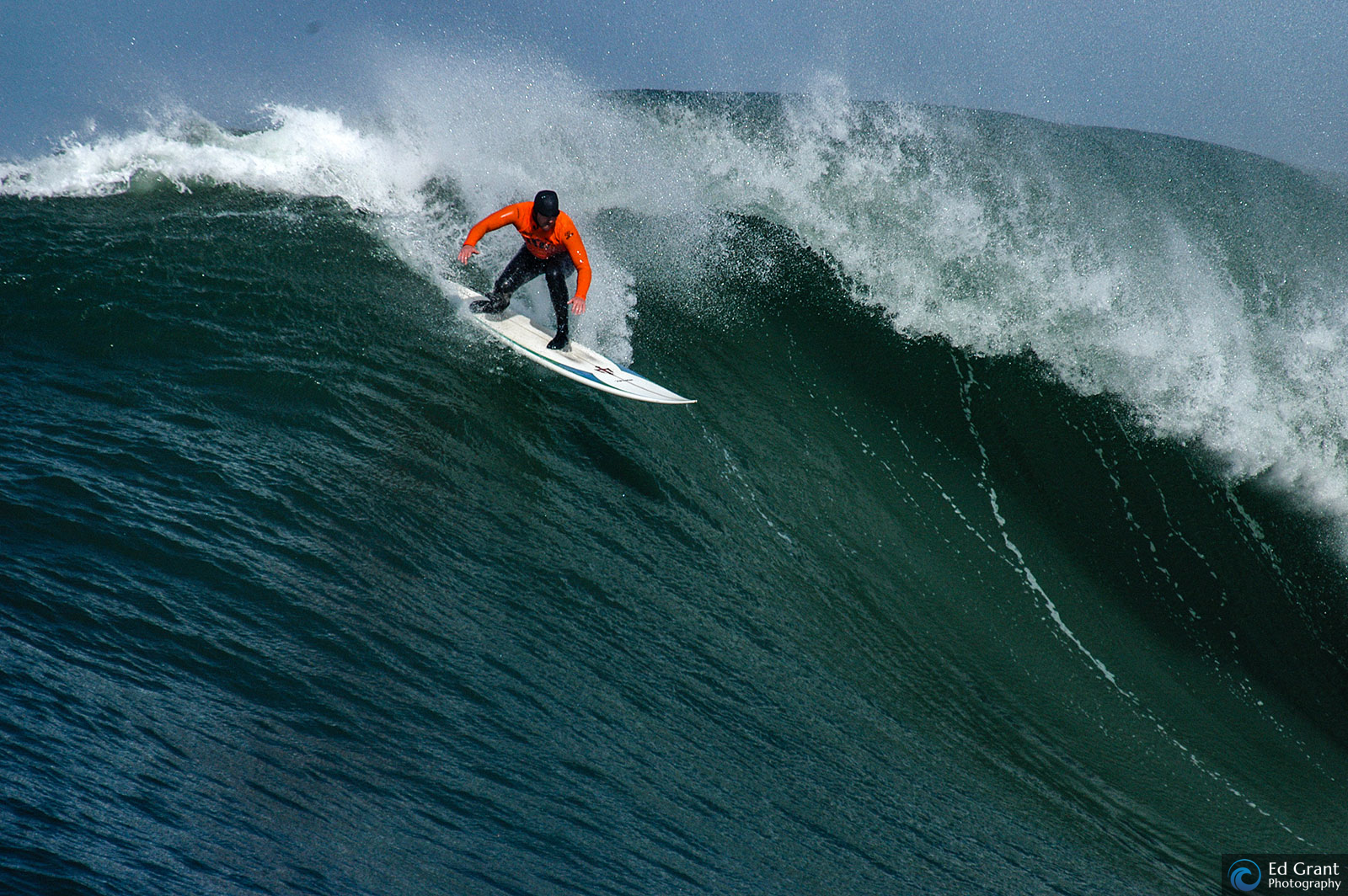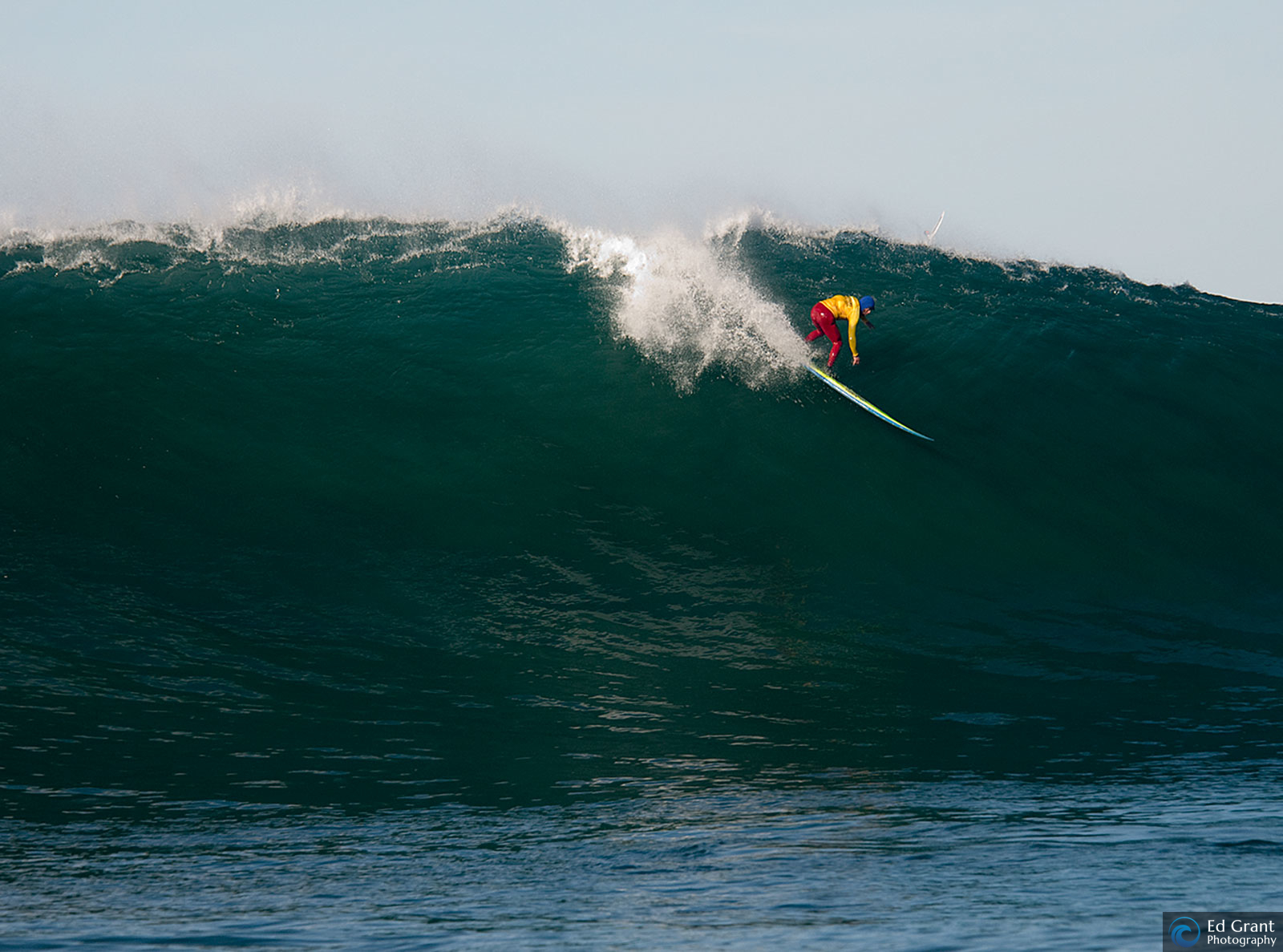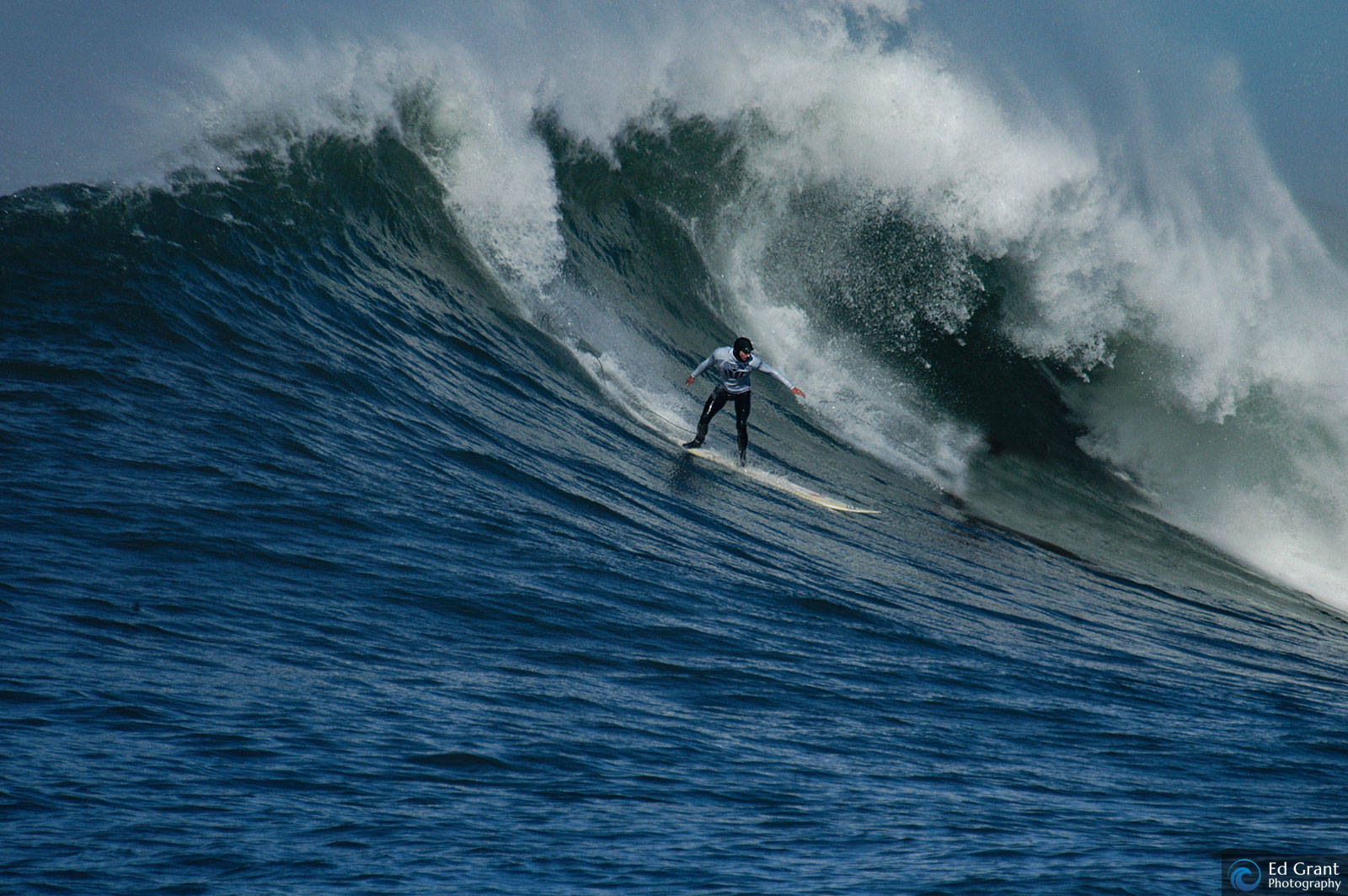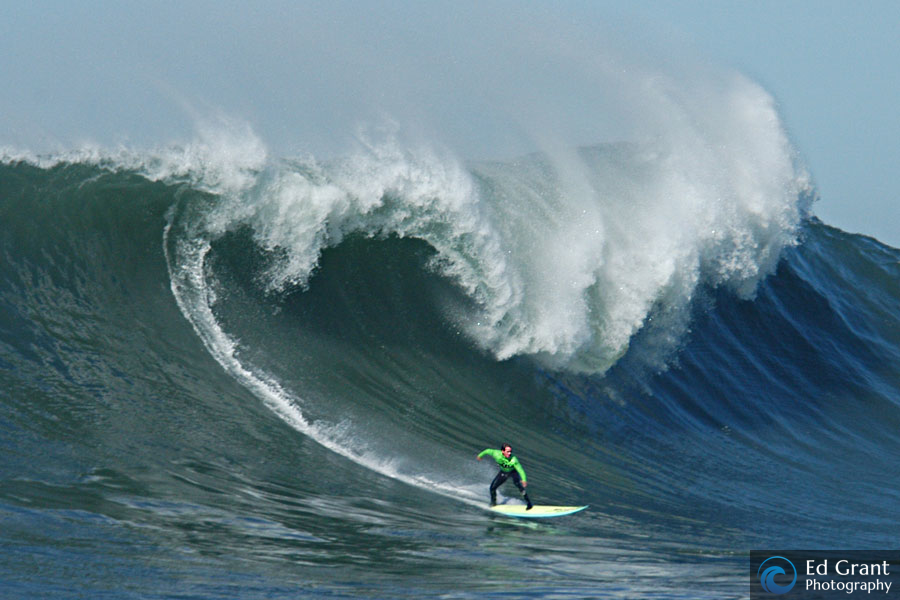Biographies
Jeff Clark is one of the most noteworthy and respected big wave surfers in the world. Jeff is considered by his peers worldwide to be a member of a small group of pioneer watermen, including the father of modern day surfing, Duke Kahanamoku and big wave pioneer and promoter Greg Noll.
Jeff is famous for surfing the giant waves of Mavericks alone for 15 years before it was widely discovered by the big-wave surfing community. Mavericks is considered by most experts in the surfing world to be the most dangerous big wave breaks wave on the planet, reaching heights in excess 60 feet.
Jeff is the only active ambidextrous big wave surfer in the world, and one of the few in history. A natural goofy-footer, Jeff spent years learning to ride regular foot with equal confidence and skill. This allowed him to ride frontside (facing the wave) when he started taking on the more dangerous right-breaking waves at Mavericks.
Labeled one of the “world’s best big-wave riders” by Surfer magazine in 1994, Clark, along with Maverick’s and the Half Moon Bay surf scene, has been featured in such films as Riding Giants, Chasing Mavericks, and Adventures in Wild California.
The annual Mavericks surf contest was founded by Jeff Clark. The invitational surf contest brings together the best and boldest big wave surfers from all over the world to Half Moon Bay.
Grant Washburn
Washburn is a leading spokesman on Mavericks & has surfed it more often than anyone over the past 18 years. He has competed in all of the Maverick’s surfing contests, reaching the semi-finals five times & the finals three. He received the Jay Moriarity Award in 2004. Grant has also been an invitee to all of the events at Dungeons in South Africa, where he has three times won the Biggest Wave Award.
Washburn is one of the world’s best & most respected big wave surfers. His projects include the Imax film “Adventures in Wild California,” the big screen hits “Riding Giants,” and he was the Surf Coordinator on Chasing Mavericks, the story of iconic big wave surfer Jay Moriarty. He co-wrote & edited the large format book “Inside Maverick’s, Portrait of a Monster Wave”.
Sarah Gerhardt on Big-Wave Surfing in a Man’s World
The first woman to ride Mavericks on her love-hate relationship with the sport, competing against other women, and why she never went pro.
Sarah Gerhardt is not a professional surfer, but among big-wave riders she needs no introduction. In 1999, Gerhardt was the first woman to drop in at Mavericks, the monster break off the Northern California coast. Just a few weeks later, Quicksilver held the inaugural surf contest there, calling it “Men Who Ride Mountains.” In fact, no woman was invited until 2016, when the contest was forced to add a women’s heat in order to receive a permit from the California Coastal Commission.
Being a pioneer in a male-dominated sport is never easy, but Gerhardt had a particularly challenging road. Growing up in San Luis Obispo, California, she and her sister cared for their mother, who suffered from severe muscular dystrophy, while their father was at sea for months at a time as a merchant marine. The family often struggled financially and she was bullied in school. But Gerhardt’s dad gave her a surfboard and wetsuit for her 13th birthday and she found refuge in the ocean. On a trip to Hawaii in college, she fell in with a crew of surfers that included big-wave icon Ken Bradshaw, and quickly found herself tackling bigger and bigger waves.
Mark Healey
A 34-year-old professional big-wave surfer, Healey has built a career chasing down the dangerous and nearly impossible. He’s a perennial finalist in the World Surf League’s Big Wave Awards—the discipline’s equivalent of the Oscars—having won the top prize in the Biggest Tube category in 2009 for a barrel in Oregon and the Biggest Paddle-In Wave in 2014 for a 60-foot monster at Jaws, on Maui’s north shore. He once won the Surfer magazine poll for Worst Wipeout, crashing on a punishing wave at Teahupoo, in Tahiti, that would have vaporized most surfers. But Healey doesn’t just ride waves—he’s in the water to swim with sharks.
As a member of a six-person scientific expedition, he was recently in Japan for two weeks to tag an endangered population of scalloped hammerheads that congregate around Mikomoto. The sharks have plummeted in numbers by as much as 90 percent, largely due to overfishing and an insatiable appetite in Asia for fin soup. The scientists hope that the data they record, such as population sizes and migratory patterns, will improve conservation policies regionally and globally.
“As a waterman, Mark is unrivaled,” says big-wave icon Laird Hamilton. “When it comes to riding giant waves, diving deep, and hunting fish, he’s the total package—unique even among us.”
Healey learned to swim before he could walk and estimates that he’s spent “a third of the year with a dive mask on since the age of 12.” He was born and raised and still resides in Haleiwa, on Oahu’s North Shore. His father, Andy, is an avid waterman who would wrap his tiny toddler in a life vest, give him a mask and snorkel, and pull him through the water clinging to a fishing buoy. “He took to it immediately,” Andy recalls. North Shore lifeguard Dave Wassel heard stories of this bobble-headed young gun who was riding giants. One day, while surfing at Pipeline, he noticed Healey “just owning it” in surf two stories tall, breaking in water two feet deep. In the parking lot afterward, Healey did something else Wassel had never seen. He pulled out a stack of phone books and put them on the driver’s seat. “He couldn’t see over the steering wheel!” Wassel says. “The kid was 17 years old, charging the heaviest waves in the world, and he needed a booster seat to drive home!”
Still, he’s no stranger to carnage, having split his kneecap in half, broken his heel, and ruptured his right eardrum four times, which left him disoriented underwater, nearly causing him to drown. Despite the dangers, he calls life as a professional surfer “the greatest scam on earth.” But he knows the ride won’t last. Now in his thirties, he has entered the decade that most pros call retirement. “The surf industry will bro you into bankruptcy,” he says. “I would rather light myself on fire than go begging for pennies as a grown man.” Instead of doubling down on contests and sponsorships, Healey is venturing into waters most surfers don’t: building businesses. Volunteering for expeditions is also part of his expanded career plan. Remote seas are expensive to explore, and trips like this are a way to scout locations for other adventures and deploy his skills for a commendable purpose. “I love having the opportunity to incorporate old knowledge like spearfishing into modern conservation and scientific discovery,” he says. Outside Thayer Walker (@thayerwalker)
Ryan Augenstein
Ryan Augenstein is part of the new generation of Santa Cruz surfers that has shown no fear when it comes to Mavericks. He is the past winner of the Heavy Water Award, basically by having no regard for his own well-being. He is not one to shy away from the biggest sets.
Ken “Skindog” Collins
Born and raised in the cold chilly waters of Santa Cruz, CA, Skinny is always a threat in any size surf, from 2 foot to 50 plus he is on it. He has had multiple cover shots, endless spreads, and many movie sections. But his career highlight was winning the XXL Ride of the Year in 2007 and the monster tube award all in one big giant spitting barrel in Puerto Escondido. He is also one of the 24 invitees in the Maverick Contest. In 2004 he had a near death experience out at Jaws in Maui, HI, which is known as the worst wipe out in the sport. Ken is known for his animated character and out spoken personality.
2018 Collins announced that he was hinging up his Mav’s guns and never paddling out again. Monday was one of the best days I have ever been out at Mavz. Grateful. @small_wave was calling it a Collectors Edition Mavz Dayz. With all the special features n shit. And that’s how I want to remember my last day surfing Mavericks for the rest of my life. So that’s it, that’s a wrap, I’m hanging up my Mavz Gunz and never going to paddle out again. I don’t want my last day to be an injury, because I feel too old, or I am bitter at the crowds. It’s because I am 50 years old (old af) and the timing is perfect. The day was perfect, the vibe was perfect, and my time to kick out…..perfect. Don’t worry y’all will see me on a boat or ski. I have been Chasing Monsters for over 30 years and now it’s time to start chasing other dreams, like epic powder days in Tahoe with my family.
Daryl “Flea” Virostko
Flea retired after 20 years of professional surfing in 2012 and founded FleaHab in 2013. His surf career is studded with glory moments. He is a three-time Mavericks contest champion, claiming the title in back to back years in 1999 and 2000 and “Flea-peating” again in 2004. “Flea sets himself apart. In his heyday, he was the man to beat and I think he still would be today if he didn’t retire,” said Maverick’s pioneer Jeff Clark. Clark added that when Virostko started surfing Mavericks, “He learned early on to surf Mavericks well, and so when the first contest came around, he was ready.” Virostko earned his nickname, “Flea,” when Vince Collier spotted the teenage surfer charging down the face of a Middle Peak set wave at Steamer Lane. Collier thought Virostko — who was barely above four feet tall at the time — looked like a flea clinging to the back of a big dog. “I loved big waves,” said Virostko. “Every time Mav’s broke, I wanted to be up there. We would paddle out and it was really uncrowded, there were no jet skis. It’s pretty crazy looking back now. We weren’t totally aware of how dangerous it was.” During the peak of his career, Virostko was earning $12,000 a month from sponsorships. Heaped on top of that were contest earnings, including $45,000 he collected from the first two years of the Mavericks event.
At Mavericks, Virostko was king. His reputation for kamikaze surfing in the heaviest waves earned him the respect of big wave surfers around the world. About his decision to retire, Virostko had this to say. “I had that thirst for Mavericks for 20 years and it’s just not there anymore. I don’t want to go out there and do something crazy. I want to see my baby grow up, I want to give other people a chance, especially younger guys that haven’t had that opportunity in life.”
Anthony Tashnick
Although he wasn’t quite an internationally known name at the time, Tashnick’s victory at the 2004 Mavericks Surf Contest was no fluke. He’s been a player on the big-wave scene for years. In 2018 Tashnick was nominated for the Men’s XXL World Surf League Big Wave Award. Tashnick was one of five surfers up for the award. It is given to the man who, according to the WSL description, “by any means necessary catches and rides the single biggest wave during the submission window based on objective analysis and measurement of the available images.” The award carries a $20,000 prize for the surfer and $5,000 for the photographer/videographer whose work is used to determine the wave size. The other two photographers/videographers will receive $750 each. Tashnick’s wave was one of the massive ones that rolled through the Maverick’s surf break near Half Moon Bay on Dec. 17. Fred Pompermayer and Frank Quirarte shot photos of the wave, while Benjamin Ginsberg submitted video. Tashnick was the only Santa Cruz surfer nominated for a WSL award. His Maverick’s wave, however, was one of three from the notorious big wave spot to be recognized. The other two Maverick’s rides were nominated in the men’s Biggest Paddle Award category. One was ridden by two-time Maverick’s surf contest champion Grant “Twiggy” Baker — one of two entries for him in the category — the other nominee for this award was Hawaii’s Nathan Florence. Tashnick was also nominated for the Men’s XXL World Surf League for the Ride of the Year for the same wave.
Greg Long
Greg Long: Born and raised in San Clemente, Greg and his brother Rusty Long were introduced to the ocean at an early age by their father, who was a lifeguard. At 15, Long first paddled out to what eventually would be his home big wave break, an island off the coast of Baja California called Todos Santos. After surfing Todos for a couple years, Long took his big wave act to spots such as Mavericks, and Dungeon’s, in Cape Town, South Africa. He won the Red Bull Big Wave Africa at Dungeon’s in 2003 at age 19. The win officially put him on the big wave map, and he has since been a standout on every huge swell all over the world.
On January 5, 2008, Long and fellow riders Brad Gerlach, Mike Parsons, and Grant “Twiggy” Baker towed into waves at the Cortes Bank off the coast of San Diego, on the swell of the decade, that were estimated to be around 60–80 feet on the face. Greg was credited by the other surfers and photographers as riding the “wave of the day” on something approaching 90 feet tall, but it was not photographed and thus not recognized. That same year, Long won the Mavericks Surf Contest in 20-foot surf.
Long has been known for caring more for the spirit of big wave surfing than the sponsorship deals, media attention, and contest wins. At the Mavericks Contest in 2008, for example, Long agreed to split the prize money among himself and the five other finalists. He is also known for pressing the limits of paddle-in surfing, paddling into many waves which were once deemed unrideable without the help of a jet ski. Long was included as an actor and adviser in the Hollywood film Chasing Mavericks, and was featured as the star of a documentary about the psychology of big wave surfing.
Rusty Long
is an explorer, journalist, professional big wave surfer, and photographer. At an early age, he and his brother Greg Long were junior lifeguards as well as surfers in their hometown of San Clemente, California. This led to Rusty’s quest for big waves; he has earned the reputation as being one of the most prominent big wave surfers in the world. To add to his big wave accomplishments Rusty has also surfed China’s Qiantang River Tidal Bore known as the “Silver Dragon” along with his brother Greg and Mark Healey in September 2008. In 2015, Long’s coffee table book, The Finest Line, The Finest Line: The Global Pursuit of Big-Wave Surfing was published. Wikipedia
Shane Desmond
Shane Desmond is a regular at one of the gnarliest, big wave breaks, Shane is one of the most respected backside rider to ever surf Mavericks. Some say you have to be “nuts” to surf Mavericks with your back to the wave. Shane has consistently done it with a fearlessness that leaves surfers shaking their heads. Known as the “Cinderella Man of Surfing” for his underdog status, Shane has ridden on some of the biggest, paddle-in waves in history including a runner-up finish at Mavericks.A dedicated family man first. “My family for me is #1. My passion is always going to be surfing big waves.”, says Shane. When Mavericks is going off and Shane is out there, everyone in the lineup keeps an eye on Shane to see what he just might pull off. – Discover Isurus Ambassadors
Jamie Sterling
Sterling is a big wave champion from the North Shore of Oahu. He began surfing at the early age of five and is one of the few people in the world who conquers 50-foot waves. He has forged a successful career of chasing waves of consequence all over the globe. As a consummate professional, his life is encompassed in the pursuit of preparedness, health, fitness, and knowledge of the crafts he uses to navigate such death-defying surfing conditions.
Sterling has become a regular fixture at the world’s heaviest locales like Cortez Bank, Jaws, Mavericks, Dungeons, Teahupoo, Todos Santos, Chile’s El Buey and El Bajo. Sterling is the 2006 Billabong XXL Performer of the Year, placed 3rd in the Mavericks Invitational in 2008, was the Pico Alto Invitational Peru Champ in 2010, is the 2011 Big Wave World Tour Champion, and was invited to the 2014 Quiksilver in Memory of Eddie Aikau Big Wave Invitational event, as well as the 2015 Titans of Mavericks Invitational. Professionalsurfer.com
Peter Mel
Peter Mel was born and raised in Santa Cruz, California. He grew up in its surf community and in his family surf shop, established in 1969 by his father, John Mel. This combination helped him become a talented surfer. Mel soon became well known in his home town and around the world for his prowess in the big wave arena surfing waves of fifty foot faces, while using his signature sweeping turns and humble demeanor. He earned the respect of his peers and in 1998 established himself as a premier big wave rider being voted eighth best surfer in the world at the Surfer Poll Awards.
Candor was always one of Mel’s better traits and by 2010, his straightforward charm was fueling a secondary career as an online personality for hosting ASP web-casts. He not only competed in the 2009 Big Wave Quicksilver Eddie Aikau event at Waimea Bay in Hawaii, he also provided commentary for much of the day. After years of chasing big wave swells and the Big Wave World Tour, it is not a surprise that Peter holds the title of Big Wave World Champion 2012 and Mavericks Invitational Champion 2012/2013. Along with his surfing career and being known for his talent as the voice of surfing, he is also a voiceover personality for Mattel Inc and has appeared in the big screen documentaries “Step Into Liquid” from Dana Brown and Stacy Peralta’s “Riding Giants”. He was cast in the feature film “Chasing Mavericks (2012)”.
– IMDb Mini Biography By: Mel Enterprises
Tim West
Tim has been surfing Mavericks and the surrounding coast for nearly 20 years with veteran knowledge of the waves and community. He was invited to many big wave surf competitions around the world, competing on the Big Wave World Tour and was part of the water rescue safety team. One of his biggest achievements in surfing was competing in the 2010 Mavericks Surf Contest which is considered one of the biggest surf events in the world. In 2019 a monster wave he rode at Mavericks was selected for XXL Biggest Wave Entry at Mavericks. The Mavericks Experience
Mark Sponsler
Sponsler is a self-taught surf meteorologist and a big wave surfer who is the creator of Stormsurf. Stormsurf.com has been the one and only surf forecast source for all variations of the Mavericks Surf contest including the Quicksilver “Men Who Ride Mountains” contests, the Mavericks Surf Contest and the Mavericks Invitational. When he was only 7 and in the years immediately following while living in South Florida, he personally experienced the destructive forces of hurricanes, with the eye passing directly overhead in two instances. This direct contact with one of natures most powerful weather systems set the stage for a lifelong quest to gain a greater understanding of the environment and it’s impac. After moving to Cocoa Beach, Florida, home of some of the world’s best surfers, he became involved in surfing and surf forecasting, fueled by the high energy surf culture there. By 1985 he began creating rudimentary surf forecasts for a small group of avid local surfers. The quest to ride larger waves drove trips to Hawaii, and by 1995, he moved to the San Francisco Bay Area, ultimately to ride Mavericks. Stormsurf has provided forecast consultation for the IMAX film “Wild California”, Dan Rather’s “48 Hours”, Ted Koppel’s “Nightline”, and numerous other TV productions that focus on big wave surfing and forecasting. Copyright © 2020 STORMSURF
Brock Little
Little was born in 1967 in Napa, California, Little’s family moved to Haleiwa when he was three years old and he began surfing at age seven. As a teenager, Little was considered to be one of the most talented and hardest-charging surfers of his era and was a stalwart figure at Waimea and Mavericks. In 1986, at only 19 years old, he finished fourth in the Eddie event, solidifying his reputation as being utterly fearless. Just a few years later, in 1990, he finished second in the prestigious contest, amid some of the most harrowing conditions ever seen in the competition.
While he would continue his search for massive surf in the coming decades, Little also began a career as a stuntman, appearing in numerous Hollywood films including Tropic Thunder, Training Days, and Transformers, just to name a few. He was also a prolific contributor to both SURFER and Surfing magazines, penning more than 30 articles. When he first announced that he was battling cancer via his Instagram account nearly a month ago, the surf world rallied around the icon. When news broke today that Little had passed, Kelly Slater wrote that Little was “Larger than life to me. The world I know will never be the same. I love you, man. Thank you…”
Chris Bertish
Bertish has broken world records in numerous big wave surfing, Stand Up Paddle Boarding and many other water based disciplines just as he has shattered perceptions of what is Possible, in everything he does. His mantra of Dream It, See It, Believe and Achieve It, has led Chris to redefine the approach to achieving success, not only across multiple sports, but also as an author, filmmaker, businessman and attaining any goal he has set for himself.
In March 2017, Chris completed his most challenging adventure yet by successfully doing something no other human being on the planet has come close to achieving. Becoming the first person ever to cross the entire Atlantic Ocean, over 7500km, alone and unsupported, on a Stand Up Paddle Board for 93 days.
Chris is not a full-time professional athlete; he’s a regular working guy. That meant he had to balance his talent and big waves ambitions with working to pay the rent. Chris created his own opportunities to pursue his dreams, running his own small business while he did the tough training. There were plenty of opportunities to get despondent and give up. But Chris never did. In Chris’s world, there is no such thing as “can’t.”
Chris is living proof that if you truly believe in something, set your sights on your goal – no matter how big – work hard at it, stay focused and never give up, you can achieve anything. Chris dares to achieve what most perceive to be Impossible. He weaves these topics into a spellbinding and exhilarating narrative complemented with powerful images and video that will blow your audience away.
Evan Slater
From Ventura, Calif., Slater is the only person to hold the editor’s post at both Surfer and Surfing magazines. He began surfing at age 9 and at 15 was the Western Surfing Association boys’ division champion. After graduating in sociology from U.C. San Diego in 1994, he moved to San Francisco where he became a regular in the Mavericks lineup and earned a reputation as one of California’s best big-wave riders. In 1999 he competed in the Quicksilver Men Who Ride Mountains Mavericks Contest. In 2001 he became the editor of Surfing Magazine.
Here is an example of Slater’s fine writing where he describes Twiggy & Tyler Smith’s performances in the 2006 Mavericks Surf Contest,: “Twiggy, was absolutely on fire. We’ve been up there at Mavericks quite a bit for the past month, surfing there and everyone been going, “This guy Twiggy is gnarly”, and I already knew he’s gnarly going into it. He was the first guy I saw Saturday night, when I got on a flight and we rushed down to Maverick’s for an evening session out there. I could tell he had a big wave sense about him. And then as the heats progressed, we were going, “this guy’s crazy.” Skindog, I can’t remember exactly what he said, but it was like, “he could be Timbuktu for all I know…but who is this guy!” He came out of nowhwere and he has been killing it. At the awards ceremony everyone was pretty sure that it was between Twiggy and Tyler Smith. Tyler is an incredible surfer out there, and one of the best goofy foots that charges the bowl, and for the final he paddled out with a red beanie on. I was like, “dude, the red beanie, you better get that off, your going to throw me off wearing that thing, get it off.” He ended up keeping it on the whole time, and he had a hood too, so I don’t know why he did that. The beanie never came off. He charged though, he had a great day. In final, there was one particular wave, that I was just a hair too far out, and I’ve been kicking myself for the last 24 hours that I should have just went anyways. But I just saw the video of the wave, and I don’t think I could have made it. So I feel better. I lost sleep over it last night.
So I had been out there from 6:30 to 4 surfing some of the best big waves I’ve seen in a long time. It was funny too, while we were out there—it was a little bit slower in the final than in the semis—and at one point, like a third of the way into it, “Twiggy” proposed that we all split the prize money. I don’t know how many people heard him, but I definitely heard him, and I immediately wrote it off. They did that at Dungeons one year, and I’m like, “they only do that in South Africa.” And sure enough, he won and I got last, so that shows me for being greedy.
Garret McNamarra
An American professional big wave surfer and extreme waterman known for breaking the world record for largest wave ever surfed at Nazaré, Portugal, surviving a monstrous wave at Jaws, and riding tsunami from calving glaciers in Alaska. McNamara was born on August 10, 1967 in Pittsfield, Massachusetts and spent much of his childhood in Berkeley, California. In Berkeley, McNamara, and his younger brother Liam McNamara, were both known by friends to be rather fearless and to shrug off the pains of rough childhood play, foreshadowing his later ability to face danger while surfing. At eleven years old, McNamara began surfing at Sunset, Waimea and the outer reefs in search of giant swells. He entered and placed in the prestigious Hawaiian Triple Crown Series at seventeen and began to gain major sponsors from major Japanese brands. In 2002 McNamara and tow-in partner Rodrigo Resende won the $70,000 purse at the Tow Surfing World Cup in Maui at Jaws . In January 2016, McNamara suffered a severe wipeout on a 50-foot wave at Mavericks in California that caused him to skip off the water three times before being swallowed by the monster-size wave. Rescuers on jet skis eventually pulled McNamara to safety, and he suffered a dislocated shoulder and a broken upper arm that required surgery. Video of McNamara’s wipeout went viral, and local surfers have said it was one of the worst wipeouts caught on video.
Jay Moriarty
(June 16, 1978 – June 15, 2001) was a surfer from Santa Cruz, California. He was an accomplished surfer, waterman, and adventurer. As a surfer, he made his reputation surfing Mavericks in Half Moon Bay, California. At age 16, he was made internationally famous when his wipeout at Mavericks was caught on film and made the cover of Surfer magazine. Although a successful competitor, Jay is remembered as a soul surfer, winning many sportsmanship awards throughout his career. A biopic of his life, Chasing Mavericks, was released in 2012.
Born in Augusta, Georgia on June 16, 1978, Jay and his family moved to Santa Cruz, California, when he was just a baby. Jay began surfing at age 9 and rode his first waves at Sewer Peak. Not limited to either a shortboard or a longboard, he was known as a versatile surfer who appreciated all aspects of surfing. This appreciation was rooted in an overall love for the ocean, seen in his accomplishments as a swimmer, paddler, diver, and fisherman. Achieving success in surfing as a youngster, he became increasingly interested in surfing Mavericks. After intense physical and mental training with his master and close friend and Mavericks regular Frosty Hesson, he began surfing Mavericks at 15 and soon became a respected regular in the line-up. A film, Chasing Mavericks, directed by Curtis Hanson, chronicling the life of Moriarity was released on October 26, 2012, with Jonny Weston playing the role of Moriarity. Moriarity died a day before his 23rd birthday on Friday, June 15, 2001, in the Indian Ocean off the coast of the island Lohifushi in the Maldives, drowning in a freediving accident.
Josh Loya
Loya began his life of surfing in 1977 at age 8 when his mother would drive him down to Cowell’s. Loya attended local schools Gault, Branciforte Junior High and Harbor High, and as he accelerated in age so did his surfing skills as he graduated to the more difficult breaks on the West Side. Attending Cabrillo College in 1991, it was only after his fifth day that his friend David Schmidt, brother of big wave legend Richard Schmidt, cajoled him into traveling to Half Moon Bay to get his first taste of the then little known sleeping giant, Mavericks. He was a semi-finalist in the 2006 Mavericks Surf Contest and nothing has made Loya want to stop charging Mavericks — certainly not beatings from two-wave hold downs or a torn MCL caused by wearing new booties that made Loya skid off the side of his board at the bottom of a 25-foot slab of the Pacific Ocean. “Free surfing Mavericks, I will always err on the side of caution,” Loya said. “However, in the contest I allow myself to take far greater risks for a higher score, because you know there are eight jet skis sitting out there on the sidelines whose sole task it is to pluck me out of the water if I eat it.”
Media exposure was where the money was, and Loya realized that Santa Cruz surfers weren’t getting much of it. To earn a living he had to enter contests and fair well enough to pay rent, buy food and pay bills. So, at 18, the young surfer entered the inaugural 1987 O”Neill Coldwater Classic, and his life as a professional surfer began. Young, single and sponsored by Billabong, Loya began to travel the world to surf havens such as South Africa, Australia and Tahiti. Contest surfing was indeed good for the kid from Santa Cruz, but big waves was where his heart lied. Praise was also handed out to Loya from the young phenom. “Josh is one of the smoothest surfers around,” Santa Cruz”s Young said. “He has his own style that stands out, that is so pleasing to watch. To me, it is one of the reasons he had such a storied career.” Loya clearly enjoys his veteran status and would gladly share his extensive surfing knowledge to any young waterman or waterwoman who wants to come forward and ask him. But he knows, very few do. “Kids nowadays want to just surf and gain their own experience, when along with that, they could be asking questions and soaking in the knowledge of those who have come before them,” Loya said. “They don”t realize we have the answers to the puzzle.” By NEIL PEARLBERG and SANTA CRUZ SENTINEL | September, 2018
Grant “Twiggy” Baker
An icon and living legend of big wave surfing. One of the giants of big wave surfing. Two-time Big Wave World Tour Champion, two Mavericks titles, 5 other WSL Tour titles, numerous WSL XXL awards, and many firsts as a surf adventurer. With a passion for exploring off-the-grid big wave breaks in remote corners of the globe. Twiggy’s exploits continue to confound conventional norms. More than just a big wave rider. Twiggy is a committed environmentalist and humanitarian. He is not one to go about flaunting it. Much of his work is under the radar. He has served as an inspiration to a generation of surfers and street kids in Africa with his support of numerous local charities. Maverick’s is my favorite event for sure, even though I haven’t gotten to compete there since 2013, and I’m itching to test myself in the bowl against this new breed of incredibly gifted big-wave surfers. The five guys behind me on the tour this year are almost WCT-level surfers, and it would give me so much joy to go head to head with them in 20-foot double ups in the Maverick’s bowl. I just hope I’m still fighting fit when that day comes!
Tyler Fox
Fox hales from the cold water and powerful waves of Santa Cruz, California. He has been fortunate enough to travel throughout Europe teaching kids to surf, mixed it up with the world’s best big wave surfers on the Big Wave World Tour as well as a recent 4th place finish in The Mavericks Invitational where he was the only goofy footed surfer to make the finals. His success is not limited to oceanic activities but also extends to running his local business Santa Cruz Waves, a print and online media outlet serving Santa Cruz County and beyond. Founded by Tyler in 2010, Santa Cruz Waves acts as a voice for environmental, social, and sports news to a growing base of readers.
Tyler has always had a deep connection with the ocean and actively supports the efforts of Save The Waves Coalition to preserve and protect this resource so our future generations can enjoy it for years to come. Source: Santa Cruz Waves
Russel & Tyler Smith
Tyler Smith sits in the cramped office of his rented studio in Santa Cruz, cracks open his laptop and logs into his passion. It’s Monday morning, just hours after the call went out for him and 23 of the best surfers anywhere to go to Half Moon Bay after daybreak the next morning to face some of the most violent waves in the worldTyler surfed for the first time, at age 6 or 7, with his father, Bob. “I rode one wave, felt the energy of the ocean and was hooked,” he says. He bought into the local code as a “grom,” surfer lingo for young male surfer, and he accepted beatings from older surfers who demanded respect. Later, he tossed rocks at tourists and hacks crowding the choice waves.
“Now I have a different view,” he says. “Those are the guys that buy the clothes that support the companies that support me. So I’ll talk to them in a calm manner.” But he’ll still knock a grom off a wave from time to time.
Next stop? The M10 board shop, where for $600 you can at least look like you know what you’re doing. Mike Coover, general manager at the shop, which sponsors Tyler and Russell, tells the elder Smith, “Half Moon Bay is 16 at 25.” There’s that code again. It means a buoy is measuring swells of 16 feet, from trough to crest, which are 25 seconds apart. The more distance between waves, the more energy each gathers.
Russell, shirtless, is at the shop with his girlfriend, an aerobic kickboxing instructor. The brothers are close but different. Where Tyler tends to plan ahead, Russell acts on whims. Russell, 25, is the one who will tell you you’re full of it, which Tyler admires. Tyler wants to know he can ride out a wave before launching into it, while Russell might paddle and hold on. Russell owes Tyler money.
The kid brother says he’s ready for Maverick’s. “I got my board and my wetsuit,” Russell says. “This is like getting up in the morning and eating bagels.”
It was during days at “the Lane,” Tyler recalls, that he began pondering Maverick’s, 50 miles up Highway 1. Darryl “Flea” Virostko, a three-time contest champion known for paddling his diminutive frame into so-called “un-makeable” waves, used to pull up with his buddies after a session there, arriving with an astral bearing.
“Their eyes were silver dollars,” Tyler says. “You’d see that look on their face — that’s called ‘Maverick’s Acid.’ ”
Now his phone won’t quit ringing. Sponsors, photographers and friends either predict that the next day’s contest at Maverick’s will be graced by epic swells or ruined by calm waters. He weighs the merits of getting wet before climbing down a rocky outcropping into the surf.
Heading back to his studio, Tyler tries to map out his Maverick’s strategy. “Same as last year,” he says. “I’ll probably just go out and — what did I do last year?” Whatever he did, he did it well enough to finish third, and collect a $6,000 prize, after coming in as an alternate, ensuring him an outright invitation this year.
Wolfing down a chicken burrito at a Half Moon Bay taqueria a couple hours later, Tyler and Russell talk about Russell’s major wipeout at Maverick’s two years ago — a “two-wave hold-down,” meaning a second wave passed before he surfaced. Big-wave surfer Buzzy Trent once said that Maverick’s can’t be measured in feet, but “increments of fear.” Russell agrees.
“I hate when people say, ‘I can hold my breath for two minutes in a hot tub,’ ” he says. “Try jumping off the balcony, landing on your head on the concrete, and then have your buddy on your way down hit you in the chest with a sledgehammer. Then try to hold your breath inside a washing machine.”
At 7:30 a.m. Tuesday, the Smith brothers launch their red and white Honda watercraft into the harbor. They aren’t just brothers, they’re tow-partners who pull each other into waves that are too big for paddling.
Before departing, the older Smith slaps two Oakley stickers on his only big-wave gun, “Old Faithful,” the 9-foot-10-inch board he’s had for six years. It just came back from the repair shop with a fresh coat of orange. “Make the sponsors happy,” he says.
He’s got a sponsor for just about everything — M10 for boards, Volcom for clothes, Body Glove for wetsuits, Oakley for shades, Vans for shoes and On a Mission for accessories, plus the Pacific Wave surf shop in Santa Cruz. Sponsors paid him about $50,000 last year, which he supplemented with prize money and profits from a surfboard-repair business that he hopes to expand. Doing well at Maverick’s could provide a sudden boost.
Tyler’s mother, Marcia, is on her way. She will settle into a spot where she cannot actually see her sons drop into the big waves. “In some ways, to not see it is better for me,” she says later.
The first round of the contest is divided into four, 45-minute heats of six surfers, who must post two scoring waves — with the highest score counting double. The waves, some of them as large as 40 feet on their faces, are crashing with a thunderous boom. The riders jockey for position, but there’s camaraderie in the dangerous surf. “How many waves do you have?” they ask each other.
Tyler is first in the second group, and he catches a big one. Fifteen minutes later, he scores well on another. He’s on his way to the semifinals along with Russell and 10 others. Tashnick and Flea are out.
There’s a moment in the water where Tyler allows the reality to sink in: He and his brother are about to push off together for the semifinal round of Maverick’s. “It was something we always dreamed of,” he says later. “I don’t know if he felt it, but I did.” The second round goes even better than the first for Tyler, who posts the highest score. But Russell is knocked out.
The big-wave finale comes down to Tyler & Twiggy. Tyler finishes second for $10,000, Baker is the champion for $30,000. In two years, Tyler has two top-three finishes, but no title yet. Incredibly, he has yet to crash on a wave.
Back on the beach, he hugs his mom but is so excited that he doesn’t notice that he keeps dropping F-bombs while talking to a television crew. It’s his best surf day, exceeding the time last March when Russell towed him into a 60-plus-footer at “Ghost Trees” off Carmel. He strained his shoulder and Russell flipped the watercraft during the rescue. The surfboard washed up later at Pebble Beach, where it was pulled from the rocks by a caddie. But that’s another story. SFGate, by Demian Bulwa, Sunday, February 12, 2006
Mike Gerhardt
Not too many big-wave specialists grew up in Malibu, but Gerhardt honed his act in Hawaii and Santa Cruz and has put in his time at Mavericks & was named as participant in 2013. Gerhardt’s wife, Sarah, is also an accomplished big-wave surf and is celebrated as the first woman to surf Mavericks.
Matt Ambrose was part of Jeff Clark’s original, Pacifica-based Mavericks crew in the early 1990s and, brings a world of talent and experience to the contest. He’s one of the most respected locals and gained some recognition for his outstanding performance in the 2000 contest when he reached the finals & finished sixth overall. He has reached the finals in two recent contests.
Nathan Fletcher
“Nathan’s an integral part of the evolution of big-wave surfing,” says Greg Long, who has emerged as the spokesman for a generation of chargers who have largely turned their backs on tow-in surfing and its reliance on technology. In fact, the genesis of the anti-tow movement can be tracked back to the morning of December 6, 2008, when Fletcher and Kohl Christenson showed up at Mavericks on a cold and foggy morning without any tow-in equipment on a day that was considered “too big to paddle.” The two considered packing up and going home, but Nathan remembers Kohl turning to him and saying with a smile, “I may never come to Mavericks again, we gotta go out there an at least get pounded on one.” As the tow-in circus swirled around them, the two battled current and dodged sets for hours, until, in close succession, each caught a bomb.
“Nathan and Kohl’s foggy day session was definitely one of the pivotal moments in the paddle-in movement,” says Greg Long. “When I saw those photos, I thought, ‘If those guys are catching waves like that in those conditions, what else is possible?’”
“We weren’t trying to bum anyone out or make a statement,” Fletcher says about the session. “We were just trying to surf.” But when it comes to defining moments, actions speak louder than words.
Shawn Rhodes
When considering the life of a standout Mavericks surfer like Shawn Rhodes, one might assume that his scariest underwater moment would be something like a two-wave hold down—an experience that has made some of the best, including Shane Dorian and Greg Long, question their hazardous profession.
Rhodes, now 46, has cemented his veteran status at Mavericks. He’s among a tight-knit crew of Northern California surfers, including Matt Ambrose and Ion Banner, whose performances at the break have been nothing short of outstanding for more than two decades. Along the way, there was a troop of Santa Cruz surfers, like Darryl “Flea” Virostko and Pete Mel, nipping at their heels with full-throttle efforts at the powerful break off of Pillar Point. Rhodes looks back on that pressure to perform kindly, grateful for the push from the star-studded Santa Cruz squad.
“In those early days, the only time it would get packed was with all the Santa Cruz guys coming up,” he says. “But it was fine—they were pushing everyone’s limits. I liked rising to that challenge, to be honest. I felt like that was my peak.”
It all traces back to that day his stepdad had to drag him into the ocean, when young Rhodes realized that the ocean was not only not as scary as he’d built up to be, but that it was actually really fun.
Rhodes spent a few years body boarding the playful waves by his home, right off Pedro Point in Pacifica. After a few years, he ditched the bodyboard and returned to surfing. It wasn’t long before he was charging waves bigger than most homes.
One day, Mavericks pioneer Jeff Clark pulled up to the Point on a solid swell and asked if they had bigger boards, as he had a secret big-wave spot that he thought they were ready for. Rhodes heeded this call to arms, and the next year ordered up some bigger boards for his quiver.“We were always talking about that elusive, perfect, and giant wave,” he says. “All of a sudden, we had it.”
Rhodes paddled out at Mavericks for the first time at age 21. Over the next two decades, he was out for every swell possible.
He’s open about his recent “retirement,” in which he has not surfed the break for the past five years. Nor Cal Surf Shop, which he opened in Pacifica 25 years ago, keeps him busy. The shop is just a stone’s throw from his beloved Pedro Point and services the local community with surf goods, such as boards from his own surfboard label, Neptune Surfboards. – Waves, March 2018, by Neal Kearney
Zach Wormhoudt
Among the most respected of the West Side crew from Santa Cruz, Wormhoudt got some long overdue recognition in 2004, when he won the XXL award for the biggest paddle-in waver of the winter. He is among the most accomplished tow-surfers in the world but is most true to his paddling. He is among the most consistently solid performers in the history of the Mavericks contest. He represents Santa Cruz well. His father Ken Wormhoudt, built the legendary Derby skatepark in 1976 that has been featured in classic skate videos and magazines. The park still stands today as a mecca for skaters visiting Santa Cruz and is a landmark to local residents. Zach is also a humble and well respected surfer in the lineup at Mavericks and has won a Billabong XXL Award for the biggest paddle-in wave one winter.
Ryan Seelbach
When Ryan Seelbach moved to Palo Alto from Del Mar in Southern California in 1985, he thought his surfing days were over. “I was so mad at my mom for taking us away from the beach,” Ryan recalls. “I didn’t want to move because I thought I’d never surf again.” And indeed during his high school years at Paly, Ryan spent more time on the football and soccer fields than in the water, landing a spot in the Silicon Valley Youth Classic All-Star football game in 1987. But fortunately for Ryan, enrollment at UC Santa Cruz in fall of 1988 gave him a chance to experience surfing in northern California, and he was soon back out on the water. While studying earth sciences as an undergrad, Ryan tested his skills on the big swells that come up each winter along the coast. When the Maverick’s Big Wave Surf Competition began in 2000, Ryan was among the first invitees.
Although by that point Ryan was already working as a geologist, he got ready for the competition by surfing the big, powerful waves at Ocean Beach near his home in San Francisco and he’s been a consistent competitor on the big wave surf circuit ever since. Considered a “Titan of Maverick’s,“ Ryan reached the semi-finals of the competition in 2007 and again in 2010, and is ready for another big showing in 2015. Maverick’s takes place between January 1 and March 31, depending on when the waves kick up; competitors have to travel rapidly to Northern California once the call goes out that the contest is starting.
Asked why he continues to risk life and limb in Maverick’s legendary 30+ foot tall waves, Ryan’s response was a bit different from one might expect. “I loved playing football at Paly, but UC Santa Cruz didn’t have a team so I was looking for something that could replace the excitement and danger of a contact sport,” he explains. “Big wave surfing gives me the same amped up energy, thrill and challenge.” While Ryan competes regularly and is sponsored by a few surf companies, he continues to work full-time as a geologist, most recently for Geosyntec, a global consulting firm with an office in San Francisco. Geosync allows him to carve out a 30 hour workweek during his peak competition times of November – March, which includes Maverick’s. He’s also a board member of Save the Waves, a nonprofit dedicated to protecting and preserving the coastal environment, with an emphasis on the surf zone, and educating the public about its value.
Staying in shape to ride the big waves is not easy with a demanding job, but Ryan gets out on the water at Ocean Beach as often as he can and augments his surf routine with weights, pilates and other kinds of cross training to prevent injury. So does Ryan consider himself a professional surfer? This Paly grad is too modest to use this description. “I am paid to surf,” he said. “But mostly I do it because I love it.” Palo Alto Post, January 16, 2015 by Victoria Thorp
Curt Myers
Myers made his name filming California’s big waves, not surfing them. With his business partner Eric W. Nelson (the ‘W’ distinguishes him from the two other Eric Nelsons in Half Moon Bay), the pair from El Granada helped put Mavericks on the surfing map by doing something that, in the early 1990s, seemed a little weird: they’d videotape Half Moon Bay locals paddling into, surfing through and getting crushed by a wave that can reach 50 feet or more.Myers graduated from Half Moon Bay High School and had a public access show, The Curt Myers Show, comprising mostly snowboard, skating and surfing footage he captured of his friends from his Canon L2 on Hi-8 film. He contributed to Powerlines Surf-Spots and convinced Eric Nelson to partner up and produce feature-length films. “Mavericks is a phenomenal place and a phenomenal wave. It’s the test of all tests,” Myers says now. “What were we going to do — just sit around and look at it? We knew there were bigger stories that needed to be told.” The newly formed Powerlines Productions released its first movie, “twelveleven”, on VHS in 1999. The pair developed their method: Myers would be in the water on a jet ski with Nelson shooting at long distance from the cliffs above. Together they’ve released ten films. Perhaps their most popular, 100 Ft. Wednesday, documents the winter of 2001–02 at Mavericks where the break saw some of its biggest waves ever and surfers pushed the limits of their sport. Today their Instagram feed is probably the best place to soak in their content. That’s where 20,000 surf enthusiasts from around the world (including 11-time World Surf League Champion, Kelly Slater, who leaves the occasional comment) tune in to follow the recent action at Mavericks.The team also plans to release a new film called Next Level, dedicated to the swell they just lived through in mid-January (Myers and the Moroccan surfer escaped the impact zone and the inside rocks) and they hope video sales alongside a movie tour will help bring in money to support their efforts.“It’s serendipitous calling the film Next Level,” Myers tells me. “That’s kind of what we want to do — get to the next level.” WRITTEN BY NickBastone, THE SIX FIFTY 2018
Tony Canadas, local coastside photographer, uses light, color and intensity to create memorable images for advertising, print media, and fine art photography. His lifelong affinity for adventure and the outdoors has led him to becoming a international publicized magazine photographer. His passion for travel has led him to countless locations around the world. From the continent of Africa to the Villages of the Himilayas, he captures exquisite moments in the expression of cultures and landscapes around the globe. It is the breathtaking beauty of the San Mateo California Coastline where he finds constant inspiration for his photography and where he makes his home.
Seth Migdail is a San Francisco based photographer, Seth has been published both in the US and internationally for his photography at Mavericks, as well as other surf photography. His photos of Grant “Twiggy” Baker” and Nathan Fletcher were nominated in the Monster Paddle-In category in last years Billabong XXL competition. Born and raised in New York, Seth journeyed to California in the mid 1990’s where he discovered his passion for surfing while living on the Central Coast. Combining his BFA in photography and his love for the ocean, Seth explore the human limits and big wave surfing with his work out at Mavericks.
Sue Pemberton, California Academy of Sciences, Ornithology & Mammalogy Curatorial Assistant I. Sue’s passion for photography began at the age of 12, when she began snapping shots of her neighborhood friends. Her childhood hobby soon grew into a full-fledged love for the art.
With a personal goal of expanding her knowledge of photography, she shoots most anything and everything in the quest for that special image.
Ed Grant & his camera, a Nikon D300 have traveled together for almost 4 decades, about the same amount of time he spent as a high school classroom teacher. Since retiring in 2002, he has photographed Half Moon Bay’s famous big wave surf break called Mavericks, capturing images of the men & women who surf the monster wave. In February, 2009, he directed a photography exhibition titled “Mavericks, Everest of the Seas”. More recently, a pictorial he shot of legendary big wave surfer, Jeff Clark, shaping a big wave gun, was featured in a window display at the San Francisco Museum of Modern Art. Grant’s skills as a photographer has landed him magazine cover shots & features in books, publications & television broadcasts as well as the Editor’s Choice of a Nikon Photo Contest. He has recently published a coffee table book titled “Piers of the California Coast”.
Fred Pompermayer, his photo of Derek Dunfee at Mavericks won the Monster Paddle Award, Ride of the Year Award, at Billabong XXL. From a very young age he was fascinated with the power of the ocean. While studying Architecture in university he took a photography class where he found an instant fulfillment. After graduating with a degree in Architecture, he boldly decided to combine his two passions of surfing and photography together, abandoned his major, and set out to become a surf photographer!
He has a very creative and unique way of shooting moments because he is always looking for something new and exciting to capture. He has the ability to build his own water housings for his cameras, flashes and even camera board enabling him to bring his ideas to fruition.
Eric W. Nelson shot the first video images of Mavericks in February 1990. On that sunny day Jeff Clark paddled out with Dave Schmidt and Tom Powers. Eric was shooting for his community access television show “Powerlines Surf-Spots”. This would be the genesis of the Powerlines Productions company that showcases big wave surfing around the world.
Nelson’s first film was “‘High Noon at Low Tide’” 1994/2005. In 1998 he produced another big wave documentary Twenty Feet Under. On December 11, 1998, during a big Northwest open ocean swell reaching 20-25 feet, Curt Myers was shooting from the water and Eric was shooting from land. On this memorable swell they joined forces and produced the mini documentary twelveleven. On this day Powerlines Productions was born.
Powerlines has footage featured in Riding Giants and other films, and maintains an impressive client list, including ESPN, The Weather Channel, Good Morning America, National Geographic, Sony Pictures and the major television networks. There are dedicated Powerlines followers on Twitter, Facebook, MySpace and YouTube.
Bruce Jenkins
Jenkins has been a sportswriter with the San Francisco Chronicle since 1973 and a columnist since 1989, traveling an award-winning path through the major sports in America and Europe. But his most burning passion has always been surfing. Jenkins grew up as a north Malibu beach kid and made certain to balance water time with his education at Santa Monica High and UC Berkeley, where he graduated in 1970.
As a coastside resident in nearby Montara, Jenkins became aware of Mavericks in 1992, not long after Jeff Clark’s secret became known to the Northern California surf community. “I knew (videographer) Eric Nelson, and he told me to join him up on the cliff when the big swells hit,” Jenkins recalled. “In those days you could walk right out to the edge of the Air Force base without any intervention, and most of the time it was just three or four of us out there. I saw a lot of historically perfect mornings, but I mostly remember being out there in the late afternoon, after all the cameras had gone home and the wind was up, watching guys like Grant Washburn, John Raymond, Mark Renneker and Bob Battalio surfing by themselves in incredibly challenging conditions. They were out there taking 30-to-40-foot drops without any jet-skis available, no inflatable vests, no rescue presence of any kind, and having the time of their lives. That was the essence of big-wave surfing to me — unbelievably heroic stuff with nobody around.”
Having devoured every Surfer and Surfing magazine ever published, Jenkins made a pilgrimage to Oahu’s famed North Shore in 1974 and has made 42 wintertime trips to the sport’s Mecca since then. He wrote “North Shore Chronicles” in 1990, leading to long associations with Surfer magazine and The Surfer’s Journal. He collaborated with Washburn and photographer Doug Acton on “Inside Maverick’s” (2006), the most authoritative book on the break and those who ride it. His work has been published in several big-wave anthologies, and he has twice been included in the annual Best American Sportswriting collection: in 1999 for a Surfer piece on the Keaulana family (west side of Oahu) and in 2014 for the Chronicle on Mavericks surfer Shawn Dollar. Most recently, he has focused on the women’s big-wave surf movement and their successful fight for equal prize money. A committed bodysurfer, Jenkins has competed several times in the Pipeline Bodysurfing Classic on the North Shore, as well as the San Francisco Bodysurf Classic at his favorite spot, Ocean Beach.
Bob Barbour
Born in Santa Monica California, Bob Barbour’s early years spent on the beach and in the surf became the foundation for his lifelong passion for the ocean, waves and the quintessential surfing lifestyle.
Bob started surfing at Malibu when he was 13 and soon became an avid surfer. Although he enjoyed photography, it wasn’t until his college days at San Diego State that he realized his true calling.The rolls of film shot on his first trip to Hawaii gave Barbour the confidence to submit them to Surfing Magazine. The photos published from that trip made it clear to him that he could, in fact, make his professional photographic aspirations a reality. Bob’s images became instantly recognizable.
His impeccable eye for detail, patience for good lighting, great rides and perfect waves landed him a Staff Photographer position with Surfing Magazine. That endeavor would turn out to be a twenty-year career before moving on to Surfer Magazine.His most famous photo, “Iron Cross” was of Jay Moriarity wiping out on a monster wave at Mavericks that became internationally famous and made the cover of Surfer Magazine.
Now, three decades later, he still calls Santa Cruz home and has amassed a historical photo library of surfing life from the area unmatched by anyone.His award-winning photography has allowed him to travel worldwide. His images have appeared in books, magazines, calendars and publications both nationally and internationally, along with exhibitions and juried art shows. Many of his limited-edition original works are hanging in collections and galleries worldwide.
Brian Overfelt
Brian with brother Peter in 2010 re-opened Old Princeton Landing to locals and visitors alike and merged it the adjoining restaurant and named the entire facility Old Princeton Landing Public House and Grill.
Peter and Brian Overfelt were raised on the Coast and grew up surfing California before they ventured all over the world. The food they ate while on surf trips in places like Australia, Indonesia, Brazil, Central America, Morocco, and Mexico left a lasting impression and has inspired much of what’s served at OPL today OPL prides itself in serving fare sourced from local farms and fisheries. Beer on tap features both local and statewide brew while the menu is chock-full of local seafood, seasonal vegetables and sustainable meats. We are dock to dish, ranch to restaurant, farm to fork.
Elizabeth Pepin
Pepin grew up in Northern California and learned how to shoot photos and work in a darkroom when she was in high school. Her images have appeared in numerous museums, galleries, newspapers, websites, and magazines, and in five books on women’s surfing including: “Surfing: The New World Order”, and Surfing: Women of the Waves. She has more than 14 years of production experience in the Bay Area and has won five regional Emmy Awards, and numerous international film festival awards for her documentary film work. Her many projects include the award winning documentary on the first woman to surf Maverick’s, Sarah Gerhardt, her climb through and beyond, unimaginable storms of childhood, and how someone who was really dealt a hard hand in life, went for her goals and made it. Sarah Gerhardt was the only woman who had ridden Maverick’s. Now there are quite a few women who have tackled the wave, each season going bigger or taking off deeper. It’s amazing to witness and an exciting time in women’s surfing. I feel very lucky to be a part of it. San Jose Mercury News, Jean Bartlett, 2016
Frank Quirarte
Quirarte, was born and raised in the Northern California coastal town of Pacifica. Frank started surfing and diving in the early seventies and developed a deep love for the ocean. After high school he enlisted in the United States Air Force and started what would be a six-and-a-half year commitment which included tours of Desert Storm and Operation Just Cause over Granada. As a reservist, he fought the fires in San Francisco’s Marina District during the 1989 Loma Prieta earthquake which devastated the San Francisco Bay Area. Frank then utilized his Air Force training during a nine-year stint with Delta Airlines as a mechanic.
After his stint with Delta he went to work with Quicksilver to run Logistics and the water-safety team for what was dubbed the Maverick’s Men Who Ride Mountains contest.
Frank began photographing Mavericks with a camera borrowed from Jeff Clark. The two fumbled through Photography 101, Maverick’s style, and managed to take a few decent shots, even getting one published in Surfer Magazine.
Frank’s skills as a photographer have landed him multiple magazine and book-cover shots, and his work has been published in over three hundred different publications worldwide. He has won multiple photo awards within the surf industry, most recently the 2006 Photo of the Year by the readers
In the summer of 2005, representing the Mavericks Rescue Team along with Bill Sharp and Matt George of Surf Zone Relief and Shawn Alladio of K38, Frank volunteered to utilize his rescue-boat skills in the hardest-hit parts of New Orleans following Hurricane Katrina. The team’s presence in New Orleans helped save many lives.
Photographers Frank Quirarte and Doug Acton have spent a combined 45 years dodging booming waves at Mavericks, scampering like mice under the feet of an elephant. The fruits of that dedication and adrenaline are some of the most jaw-slackening images ever captured at the formidable surf break. “There are no other photographers who have the eye and the experience for capturing dramatic Mavericks moments,” said Grant. “Nobody else has the body of work that they have.” Acton, 57, is a lifelong surfer and ocean lover who grew up on the Peninsula. He got involved with Mavericks in 1991, when the spot was known to only a small group of locals and big-wave surfers. The Half Moon Bay resident says he was the first photographer to use a Jet Ski there — he’d grown tired of relying on flaky boat operators. Quirarte became captivated by Mavericks during the legendary swell that smashed into the coast in late December 1994. It was an astonishing week of surfing, but it ended in tragedy with the death of seasoned Hawaiian surfer Mark Foo, who drowned after pitching forward off his board in what appeared to be a routine wipeout.
Foo’s death was a wake-up call for the entire big-wave community about the power and danger of Mavericks. But Acton’s commitment to the spot never wavered, and Quirarte’s fascination grew. Quirarte began shooting whenever Mavericks went off and was a quick study on the Jet Ski. The Pacifica resident became known for his skill and daring in the water and established himself as a key component of the Mavericks rescue team. Out in the Mavericks lineup, Quirarte and Acton are like gnats circling a bull. They zip in front of a towering wave, snap a few photos, then hustle out of harm’s way. They capture side angles while riding up the shoulder, shooting with one hand and driving with the other. “One little change in angle at Mavericks can change the entire look of the shot,” said Quirarte, 51. “It’s taken me 20 years to really know and learn the lineup.”
That experience has turned the pair into sought-after experts — Quirarte aided in the production of the 2012 movie “Chasing Mavericks” and Acton has published a book of his photographs, Inside Mavericks, Portrait of a Monster Wave, — and opened doors to other opportunities. Quirarte shot the 2013 America’s Cup, for instance, while Acton photographed some of extreme skiing pioneer Scot Schmidt’s seminal runs in Squaw Valley.
The two men have spent countless hours together over the past two decades. They consider each other brothers — with all the bickering that word entails, often peppering each other with insults.
“You love your brother the hardest and you also hate him the hardest, and that’s the way it is with Frankie,” Acton said. “The thing with Frankie is I always know he’s there to protect my back. And he’s really good at that.”
Ross Clarke-Jones
Born in 1966 in Sydney, Australia. Ross became an established big wave surfer at the 1986 Billabong Pro at Waimea bay and the Pipeline Masters. Ross spent 12 years on the ASP World Tour. He starred in and produced the most iconic surf films including “Mad Wax”, “The Sixth Element” narrated by Dennis Hopper, “Storm Surfers 3D” and the four part TV series “Storm Surfers”. In 1999 Clarke-Jones paced 3rd in Quicksilver’s Men who Ride Mountains Contest at Mavericks. Ross was the first Australian and non-Hawaiian to win the prestigious Quicksilver In Memory Of Eddie Aikau held in Waimea Bay, Hawaii in January 2001. In 2004 and again in 2016 he took second place at that elite big wave competition. Ross divides his time between Portugal, Hawaii and Australia. Basing himself in Bells Beach, Australia – chasing fierce swells in the southern hemisphere in places like South Africa, New Zealand, Tasmania or Western Australia.
Doug Acton
Doug Action: Acton is a former senior photographer at Surfing magazine. He authored the most popular and authoritative book on Mavericks, “Inside Maverick’s: Portrait of a Monster Wave”. His photographs of Maverick’s have appeared on numerous magazine covers, and he was one of the first photographers to consistently shoot big waves from a WaveRunner. He lives in Half Moon Bay with his family.
Doc Renneker
Dr. Mark Renneker is a board-certified family physician who lives in San Francisco. He has a unique medical practice that he describes as clinical advocacy. He specializes in working with patients and families who are facing complex medical situations. He has sponsored workshops at Commonweal on clinical advocacy and now teaches a course on the subject for medical students at University of California-San Francisco, where he is on the clinical faculty. Mark is also a dedicated surfer, and is the founder of the Surfer’s Medical Association which has sought to improve health conditions of often poor populations near surf destinations around the world. He has surfed giant waves from the Arctic to the Antarctic, but surfs regularly at Maverick’s and Ocean Beach, where he lives with his wife, the painter Jessica Dunne, and their large iguana. -Commweal, June 2015






